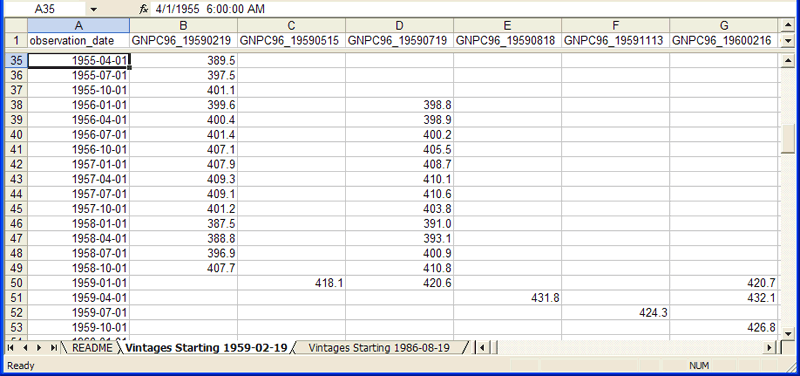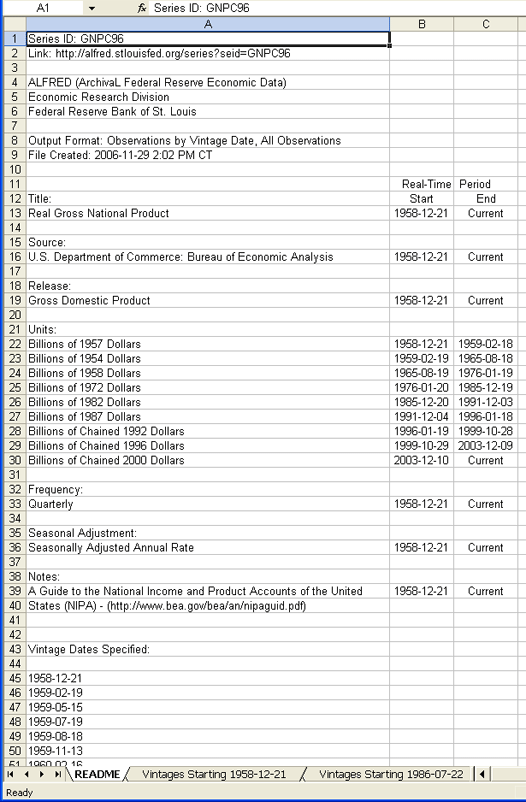Select Vintage Dates When Data Were Revised
Observations by Vintage Date (Both "All Observations" and "New and Revised Observations Only")
Observations by Vintage Date, All Observations
Observations by Vintage Date, New and Revised Observations Only
Observations by Real-Time Period
Observations, Initial Release Only
The examples in this document are based on Series: GNPC96, Real Gross National Product. On each series page, you can select a "Download Data" link to go to a download data form. Below is a description of the various options on this form.

Vintage Dates
A vintage date is a date in history used to download data as it actually existed on that past date.
Select Vintage Dates When Data Were Revised
Select one or more vintages dates when the data for this series were revised. These vintages dates closely correspond to the release dates for this series. Note that if the series was not revised on a particular release date, the release date is not included in this list of vintage dates.
And\Or Enter Vintage Dates
Enter one or more vintage dates separated by spaces. Sometimes it may be useful to enter a vintage date that is not a date when the data values were revised. For instance you may want to know the latest available revisions on 2001-09-11 (World Trade Center and Pentagon attacks) or as of a Federal Open Market Committee (FOMC) meeting date. Entering a vintage date is also useful to compare series on different releases with different release dates.
Output Formats
Observations by Vintage Date (Both "All Observations" and "New and Revised Observations Only")
These output formats are a cross tabulation between the series' observation dates and the specified vintage dates. The first column contains the observation dates for which the data values are measured. The first row contains the vintage dates that specify dates in history and what data actually existed on past dates. The interior cells contain data values for specific combinations of observation dates and vintage dates.
A single column holds constant the vintage date and contains data values varying the observation date. A single row holds constant the observation date and contains data values varying the vintage date.
Observations by Vintage Date, All Observations

For this output format, a single column contains all observations actually available on a specific date in history, and a single row contains data values for the same observation date but on different vintage dates or dates in history. Often for a single row, the data values do not change from one vintage date to the next. This means that the data values have not been revised even though the date in history has changed.
Observations by Vintage Date, New and Revised Observations Only

For this output format, a single column contains only data values that were revised or made first available on that vintage date. Data values that were not revised on a vintage date are not displayed.
Observations by Real-Time Period

This output format contains 4 columns: the observation date, the data value, the real-time period start date, and the real-time period end date. The observation date is the date for which a data value is measuring. The data value column contains revisions to values. The real-time period start date defines the first vintage date for which a data value is the latest revision available. The real-time period end date defines the last vintage date for which a data value is the latest revision available. Only data values having real-time periods that contain one or more of the specified vintage dates are displayed.
Note that the real-time period end date is not known for the revisions that are valid as of today. In the future, these values may or may not be revised. If values are revised, the date of the revision is not known. For these reasons, the real-time period end date is missing or not defined for the revisions valid as of today. These missing values are represented as a "." in the text format and "#NA" in the Excel format in the "realtime_end_date" column.
Observations, Initial Release Only

This output format only contains the first released values for each observation. Subsequent revisions to these values are not displayed. This output format is very similar to the output format "Observations by Real-Time Period" except that the realtime_end_date column is not displayed. In this output format, the realtime_start_date column contains the dates when initial values were released to the public.
File Format
Both the Excel and text file formats are zipped thus making the files smaller and quicker to transfer. Both file formats contain a README worksheet or file. The README worksheet or file contains the series attributes (e.g., Title, Source, Release, Units, Frequency, Seasonal Adjustment, and Notes) by real-time period that contain one or more of the specified vintage dates. At the bottom of the file, the specified vintage dates are listed.

Zipped Excel
For the output formats "Observations by Vintage Date, All Observations" and "Observations by Vintage Date, New and Revised Observations Only", the data worksheets have names such as "Vintages Starting 2000-12-31". In this case, "2000-12-31" is the first vintage date on the worksheet. A single worksheet is limited to 256 columns. Subsequent worksheets are created if more than 255 vintage dates are specified.
Zipped Tab Delimited Text
This file format contains 2 files when unzipped: a README file and a data file. The data file contains all data for the specified vintage dates regardless of output format.